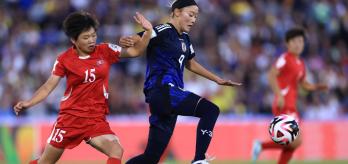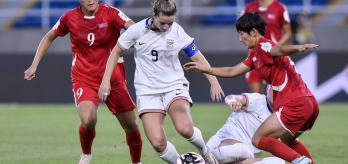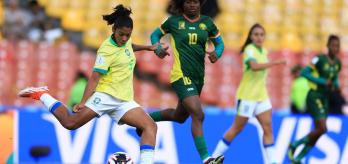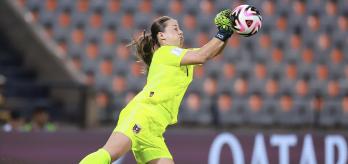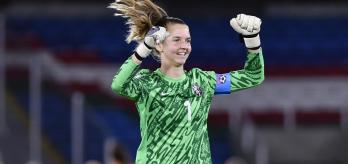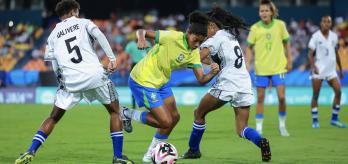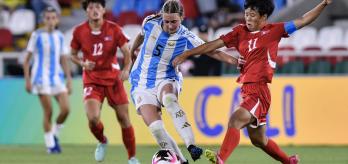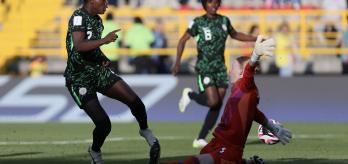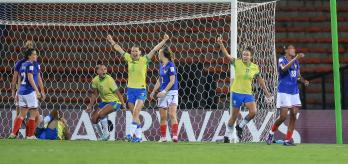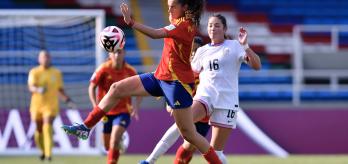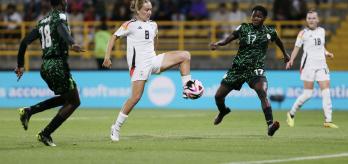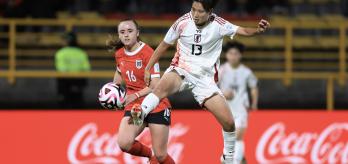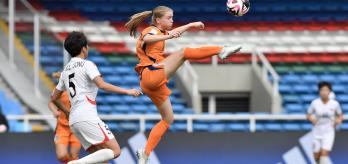Once it has been established that defenders are not in a position to intervene and that the goalkeeper is the only one who can, they must defend their goal. Our Technical Study Group and Football Performance Insights Team are onsite in Colombia, attending all games at FIFA U-20 Women’s World Cup Colombia 2024™ and for Pascal Zuberbühler, the standard of goalkeeping in 1v1 situations throughout the tournament has been very high.
“When 1v1s occur in games, goalkeepers have a split second to react because they are on their own. These moments require courage, focus and a strong mentality and I was so impressed with the attitudes of the goalkeepers when they were in these situations. Also, the understanding between defenders and goalkeepers when 1v1s occur has been very good, with defenders knowing that their goalkeeper will commit to the situation so they can provide cover elsewhere. They must know if their goalkeeper will stay high in these situations, will she come out to make the block, is she good and brave in these situations? This understanding shows that they are training this together and this is very important,” Zuberbühler added.
Up to, and including the semi-finals, the data provided by our FPI team shows that goalkeepers are facing marginally more 1v1s, with 1.0 per 60 minutes effective playing time in this tournament, compared to 0.9 in 2022. However, goalkeepers are saving 34.7% of the 1v1s faced in 2024 compared to a save rate of 30.6% in 2022.
The 1v1 situation
When in the 1v1 situation, goalkeepers must understand the relationship between the location of the 1v1, and the goal. Depending on which side the attack is coming, or if it’s a central attack, influences the blocking stance of the goalkeeper as they look to make themselves as big as possible to reduce the angles and space available for the attacking player to make an attempt at goal.
According to Zuberbühler, “Most goalkeepers have a favourite side where they can stretch a little bit more on that side. If it’s coming on the left or right side of the pitch, you need to know which side you need to extend on the most, to cover as much of the goal angle as possible. It is also crucial to get as close to the attacker as possible as this makes you bigger and the more successful the x-block can be.
“The starting position is important but also the timing. When, and if, the attacking player has the ball under control, this can be a difficult situation for the goalkeeper especially if they can take another touch before opening the body to make an attempt at goal. The goalkeeper needs to attack and come forward when the attacking player takes their final touch before opening up to strike at goal. Once they open up, the goalkeeper must make themselves as big as possible, using the x-block to be big and imposing in front of them. You must sense these situations, and, in this tournament, we’ve seen some goalkeepers read these situations fantastically,” he added.
In addition to these key elements of judgement, goalkeepers must be brave and strong. They must be prepared to use every part of their body, at full stretch to protect their goal. They need to be fully focused with their eyes firmly on the ball and a clear mind that does not fear getting hit by the ball in the body or face. As can be seen in the clips below, this bravery, focus and attitude from goalkeepers in 1v1 situations in this tournament, has been impressive.
Goalkeeping examples
Here, Zuberbühler explains in detail the key components of some impressive 1v1 saves from FIFA U-20 Women’s World Cup Colombia 2024.
“Clip 1 is a counter-attack situation from a Germany corner in their group-stage match against Nigeria. The German defence is wide open as Chiamaka Okwuchukwu (2) breaks forward with the ball under control in a clear 1v1. Goalkeeper, Rebecca Adamczyk (1) initially retreats (when she could have stayed higher) to give her defender time and space to see if she could recover to provide any support. This was a perfect example of playing together. She stays on the six-yard line, in the set position with her bodyweight forward until the striker entered the penalty area. As soon as Okwuchukwu takes her last touch before opening up to strike at goal, Adamczyk advances at speed, making herself big, before making a great save in the x-block position. Her strength, attitude and judgement are all impeccable here. This is a masterful example of a 1v1 save.”
“In clip 2, we see just one of a number of great goalkeeping interventions made by Morocco goalkeeper, Fatima El Jebraoui (12) who saved in all four of the 1v1 situations she faced. In their group-stage match against USA, she played very offensive and defended her zone with a lot of bravery. In this situation, she came out, and she could have stayed because her defender Hajar Said (21) was close. The interesting thing here is the relationship between these two Morocco players because as soon as Said sees that her goalkeeper has come out, she changes direction, leaving her goalkeeper in the 1v1 and makes a clear run to defend the goal. This a superb example of players knowing each other and understanding their roles in their different situations. It is clear that El Jebraoui trains with her team and not in isolation because this type of understanding comes from training together. The goalkeeper advances, making herself as big as possible and never takes her eyes off the ball. She does not shirk at the prospect of getting hurt and saves with her face. In a situation like this, it is important to have the right distance from the attacker and that you don’t have the defenders, striker and goalkeeper all going for the same ball, so the role understanding is here is clear.”
“Clip 3 comes from a counter-attack situation for Ghana against New Zealand. Because the recovering midfielder Lara Colpi (13) is close to the attacker, goalkeeper Madeleine Iro (18) could have stayed, but she makes a very good judgement to come out and when the striker was opening to take the shot with her right foot, we can see how she has spread her arms out, making herself big in a nice x-block, and makes a good save.”
“Finally, in clip 4 we see a great 1v1 save from Cameroon goalkeeper Cathy Biya (1). When Colombia forward, Linda Caicedo (18) plays the through pass, Biya immediately recognises that her last two defenders cannot make an intervention and makes a great decision to come out. She sprints forward knowing that she must defend the goal here, because this is a clear 1v1. Even though her distance is about five metres away (which is a little bit far for an x-block), the attacker Yésica Muñoz (9) gets disturbed a little by recovering defender Bernadette Mbele (12) and this helps. However, Biya is brave in this situation, has good positioning and shows great flexibility and athleticism to stretch to make the save. Her focus and courage in this situation also contribute to this excellent save and she saved all three of the 1v1 situations she was in during this tournament.”
KEY INSIGHTS
-
As soon as a goalkeeper recognises they are in a 1v1 situation, they must defend their goal. To have the best chance of making a save, the goalkeeper must try to get as close to the attacking player with the ball as they can, making themselves as big as possible to reduce the angles for an attempt at goal. The timing of this final advancement towards the player with the ball must come just before they are opening up to strike at goal. When they are preparing to strike, that is the moment to make the x-block.
-
The goalkeeper's relationship with their defenders is very important, first the judgement that their team-mates cannot intervene and secondly that recovering defenders understand how and where to support their goalkeeper when they are engaged in a 1v1.
-
In these 1v1 situations, goalkeepers must show strength, courage and be focused, to make it as difficult as possible for the attacking player to score.






